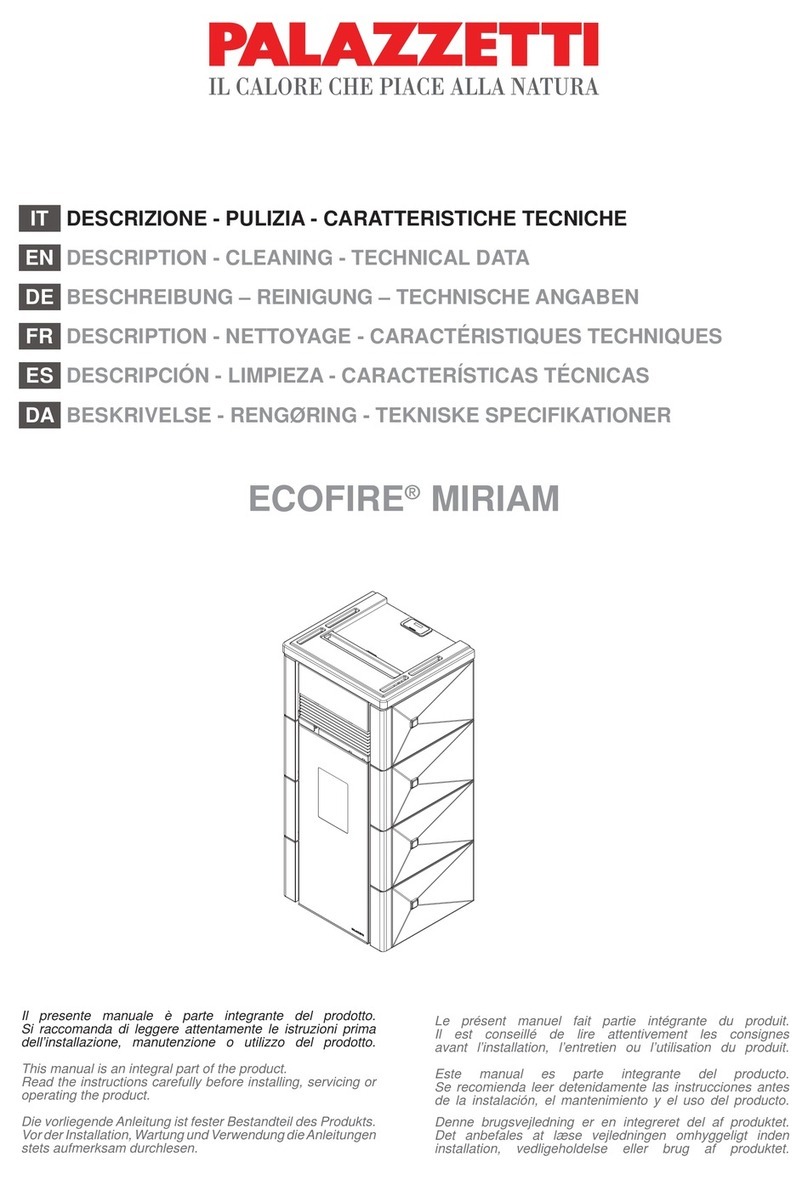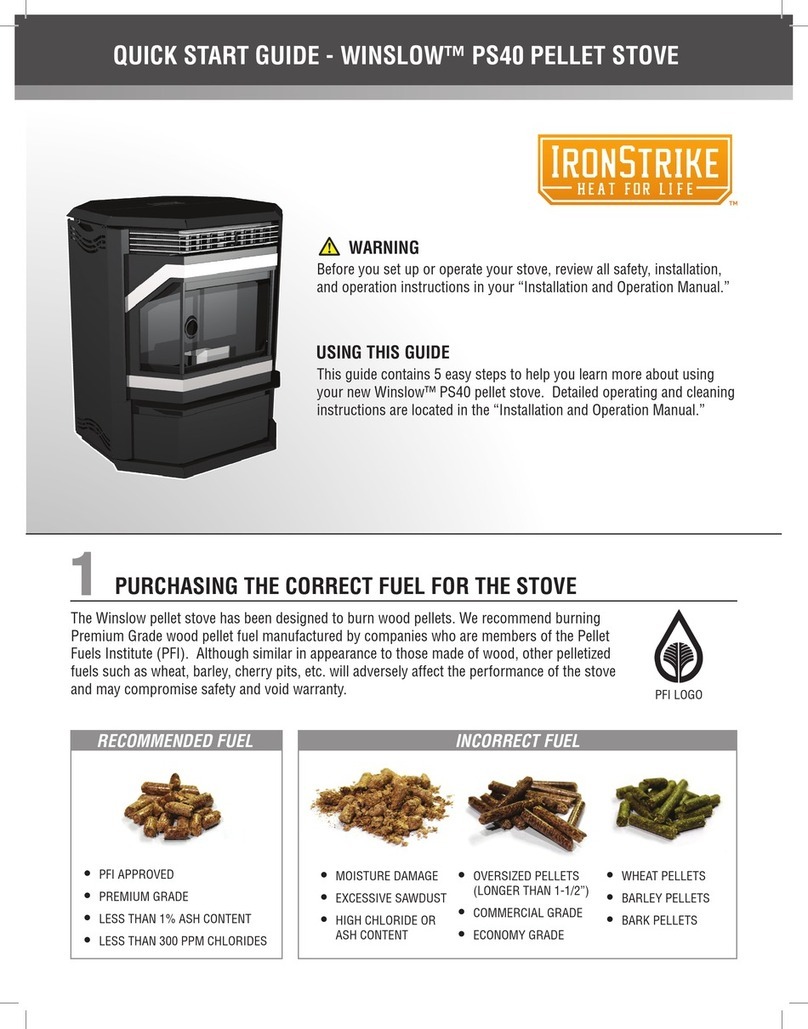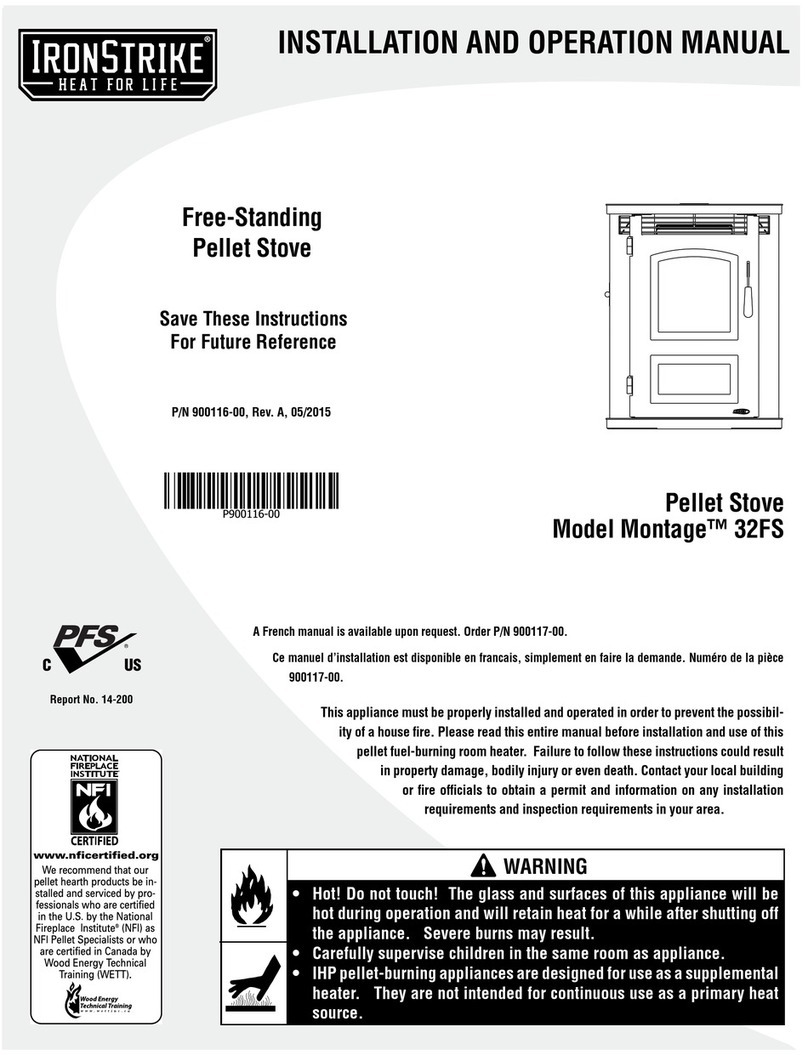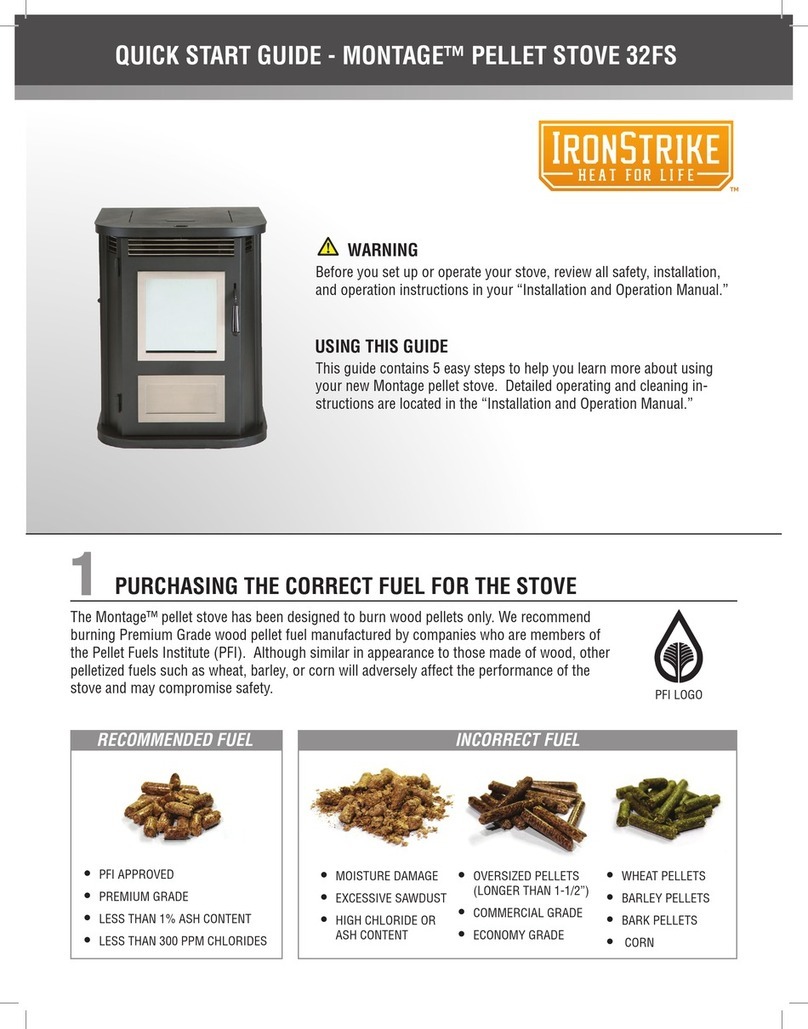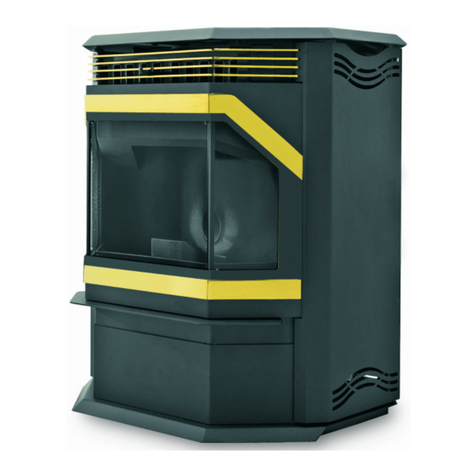
2
1. DO NOT CONNECT THIS UNIT TO A CHIMNEY FLUE CON-
NECTED TO ANOTHER APPLIANCE.
2. Do not connect this appliance to air ducts or any air distribu-
tion system.
3. DO NOT INSTALL A FLUE DAMPER IN THE EXHAUST VENTING
SYSTEM OF THIS APPLIANCE.
4. Do not use class B venting intended for gas appliances as a
chimney or connector pipe on a pellet fired appliance.
5. The minimum clearances must be maintained for all com-
bustible surfaces and materials including; furniture, carpet,
drapes,clothing,wood,papers,etc.Donotstorecombustibles
within this clearance space (see Clearances on Page 5).
6. INSTALLATIONDISCLAIMER-Thisstove’sexhaustsystemworks
with negative combustion chamber pressure and a slightly
positive chimney pressure. Therefore, it is imperative that the
exhaust system be gas tight and installed correctly. Since IHP
has no control over the installation of your stove, IHP grants no
warranty,impliedorstatedfortheinstallationormaintenanceof
yourstove,andassumesnoresponsibilityforanyconsequential
damage(s).
7. Burning any kind of fuel consumes oxygen. If outside air is
not ducted to the appliance, ensure that there is an adequate
source of fresh air available to the room where the appliance
is installed.
8. The appliance will not operate using natural draft, nor without
a power source for the blower and fuel feeding systems.
9. Never use gasoline, gasoline-type lantern fuel, kerosene,
charcoal lighter fluid, or similar liquids to start or “freshen up”
a fire in this heater. Keep all such liquids well away from the
heater while it is in use.
10.The authority having jurisdiction such as municipal build-
ing department, fire department, fire prevention bureau, etc
shouldbeconsulted beforeinstallationtodeterminetheneed
to obtain a permit.
11.APPROVED FUEL: This appliance is designed specifically
for use only with pelletized wood fuels only. This appliance
is designed and approved for the burning of wood residue
pellets with up to 2% ash content. This appliance is NOT
approved to burn cardboard, nut hulls, cherry pits, corn, etc.
regardless if it is in pellet form. Failure to comply with this
restriction will void all warranties and the safety listing of
the stove. Consult with your IHP dealer for more information
on approved pellet fuels.
12.CONTINUOUS OPERATION: When operated correctly, this
appliance cannot be overfired. Continuous operation at a
maximum burn can, however, shorten the life of the electri-
cal components (blowers, motors, and electronic controls),
and is not recommended. Typical approved operation would
includerunningatthelowtomidrangesettingwithoccasional
runningon themaximum settingduring thecoldest periodsof
the winter. The blower speed control should be turned to high
when operating the stove on the high heat setting. DO NOT
OVER-FIRE THIS STOVE. Follow all instructions regarding
the proper use of this stove.
13.CAUTION:NEVERPUTFINGERSNEARAUGER. Thisappliance
isequippedwitha hopperlidswitch,whichisdesignedtostop
the auger when the hopper lid is opened. NEVER DISCONNECT
OR BYPASS THIS SWITCH FOR ANY REASON. Pellet fuel is fed to
the UltraGrate™ by a screw auger. This auger is driven by a
high torque motor. The auger is capable of causing serious
harm to fingers. Keep pellets in the hopper at all times and
keep fingers away from auger. The auger can start and stop
automatically at any time while the stove is running.
14. CAUTION: HOT WHILE IN OPERATION. An appliance hot
enoughtowarmyourhomecanseverelyburnanyonetouching
it. Keep children, pets, clothing and furniture away. Contact
maycauseskinburns.Donotlet childrentouchthe appliance.
Train them to stay a safe distance from the appliance.
15.Fly-ash BUILD-UP: For all wood pellet fuel-burning heaters,
the combustion gases will contain small particles of fly-ash.
This will vary due to the ash content of the fuel being burned.
Over time, the fly-ash will collect in the exhaust venting
system and restrict the flow of the flue gases. The exhaust
venting system should be inspected regularly and cleaned
as necessary.
16.SOOT FORMATION: Incomplete combustion, such as occurs
during startup, shutdown, or incorrect operation of the room
heater will lead to some soot formation which will collect in
the exhaust venting system. A precautionary inspection on
a regular basis is advisable to determine the necessity of
cleaning. The exhaust venting system should be inspected
regularly and cleaned as necessary.
17.DISPOSALOFASHES:Ashesshouldbeplacedinasteelcontainer
with a tight fitting lid and moved outdoors immediately. The
closed container of ashes should be placed on a noncombus-
tible floor or on the ground, well away from all combustible
materials, pending final disposal. If the ashes are disposed
of by burial in soil or otherwise locally dispersed, they should
be retained in the closed container until all cinders have been
thoroughly cooled.
18.The instructions must be strictly adhered to. Do not use
makeshift methods or compromise in the installation.
19.Do not abuse the door glass by striking, slamming or similar
trauma. Do not operate the stove with the glass removed,
cracked or broken.
20.SAVE THESE INSTRUCTIONS.
21.See the listing label on the appliance.
IMPORTANT SAFETY AND WARNIING
INFORMATION
READ THIS MANUAL IN ITS ENTIRETY AND UNDER-
STAND THESE RULES TO FOLLOW FOR SAFETY.
WARNING
Do not attempt to alter or modify the construction of
the appliance or its components. Any modification
or alteration may void the warranty, certification
and listings of this unit.
WARNING
Improper installation, adjustment, alteration, ser-
vice or maintenance can cause injury or property
damage. Refer to this manual. For assistance or
additional information consult a qualified installer,
service agency or the gas supplier.
